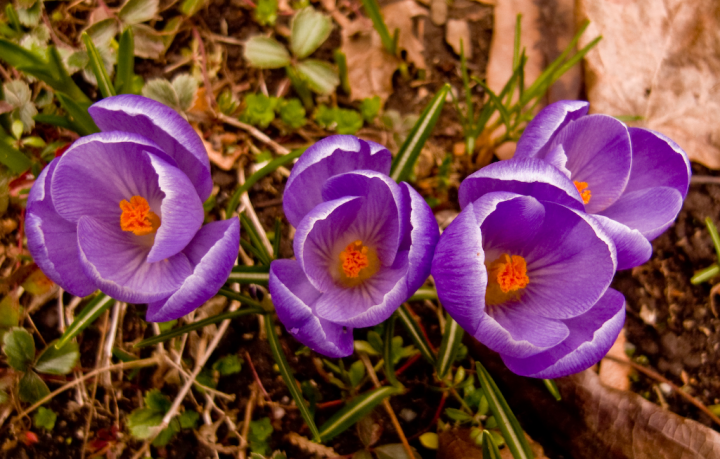
Purple Raindrops

Three pictures of droplet-studded violet crocuses. Spring sunshine is lovely, but there are things to like about spring rain too. With some camera commentary.
The middle flower has been splashed with bits of soil by the just-ended rainstorm, and I thought about picking them off but ended up liking them.
These photos highlight both a strength and a weakness of the GX100. On the upside, the Macro setting is absolutely fabulous. People have complained that the autofocus is a little slow and yeah, it zooms back and forth for a second or more before it locks on. So what? I use Macro to shoot things like flowers and rocks that hold still, so I don’t care. When it locks on, it’s on, the depth-of-field seems to be just what you’d want, and the bokeh pleases my eye.
On the downside? The dynamic range is limited, and thus it’s really easy to blow out the highlights. That middle flower is partly white, and this is my third attempt to photograph it; the first two lost the whites. Under a brightish grey sky, I had to knock the AE correction down to -0.7EV to get what you see here.
Comment feed for ongoing:
From: Zonker (Mar 11 2008, at 12:45)
Interesting that you were unhappy with some aspects of the photos -- frankly, I thought they were amazing. Maybe they don't look exactly like what you'd see with the naked eye, but the color seems fantastic to my untrained eye.
[link]
From: Sam Greenfield (Mar 11 2008, at 14:04)
You might want to try playing around with high dynamic range photography. In short, you shoot in RAW mode, capture the file seveal times using different exposures and color settings and merge them manually or with photoshop's HDR function.
This is actually not a new technique. Back when I was with Sports Illustrated during the film days, we would occasionally come across a slide with multiple lighting conditions. When that happened, the slide would be scanned multiple times: once for each lighting condition. Finally, an 8-bit composite file would be created.
Of course, the human eye is still great at doing this sort of lighting compensation automatically. :-)
Check out http://blog.photoshelter.com/2007/12/high_dynamic_range_photos_hdr.html and http://www.stormtrack.org/forum/showpost.php?p=107289&postcount=12 for some more information. (You can also license the last image at http://psc.photoshelter.com/image/I000027108)
(Disclaimer: I am a software engineer at PhotoShelter.)
[link]